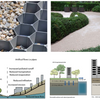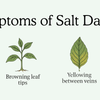What to do in your wicking bed this month - Jan 21

Posted: 6 Jan 2021 by Eric Sturman
Growing Vegetables in Wicking Beds
This post will give you some practical advice on how to grow a range of different vegetables in your wicking bed. We will try to address the different challenges that may be faced by the different climatic zones across Australia over the course of the year.
In this 2nd issue, we will start our journey into growing vegetables using a WaterUps® wicking system. Each month we will focus on the appropriate seasonal vegetables that will grow best in wicking beds. We will give you tips along the way on how to maintain plant health and maximise productivity. Since I will really be giving a running commentary of what is happening in my garden, I think that a brief description would be useful. Originally, I had 6, large <2m x 1.5m> non-wicking raised garden beds. I retrofitted two with WaterUps® cells straight away, and since they have been performing so well, I decided to upgrade the rest. Even though I will be losing almost half a square metre per bed, I am swapping one of the old beds for two of the new and putting them only 40cm apart on the long side. It’s wide enough for a rake and I like being able to walk between the new beds. I had to walk on my old beds to get to the middle and I am planning on harvesting a lot more from the wicking beds anyway. The sketch below shows the layout.
 During the heat of last summer, I was giving each of my beds 10 minutes of water a day. While it did rain on occasions, which kept my water tanks reasonably full, it was taking an hour every morning to water. I still spend an hour in my garden every day, but now with my wicking beds, watering doesn’t need to be the first thing anymore. And for the record, I have filled the first bed up three times since it went in 8 weeks ago. Now we have had a lot of rain, but there have been some hot and windy days too. There is a picture of me next to the zucchinis I planted in that first bed in early November on my first blog.
During the heat of last summer, I was giving each of my beds 10 minutes of water a day. While it did rain on occasions, which kept my water tanks reasonably full, it was taking an hour every morning to water. I still spend an hour in my garden every day, but now with my wicking beds, watering doesn’t need to be the first thing anymore. And for the record, I have filled the first bed up three times since it went in 8 weeks ago. Now we have had a lot of rain, but there have been some hot and windy days too. There is a picture of me next to the zucchinis I planted in that first bed in early November on my first blog.
Protecting against the summer heat
January in Sydney is hot. Last year it was dry and hot, this year is expected to be wet and hot. No matter what the moisture level is in your soil, a 40 degree day will burn the leaves of your vegetables. Tomatoes, lettuce, and zucchini are very susceptible and will benefit from a temporary shade structure to get them through the hottest days. Shade cloth comes in different grades depending on the amount of sun that is being blocked out. 50 – 70% block out is what you are after. A few stakes in the ground and the cloth draped over is all that is needed. The structure only needs to last for a day or two at a spell. By now you probably have a good range of vegetables growing and it is time to think about replacing some of your tired plants that you started in spring. With 12 weeks still to go before Autumn, there are still a lot of opportunities to get another few crops in.What to plant in my wicking bed?
What you grow should really be a reflection of what you like to eat. It might sound silly, but over the years I have grown masses more food than my family eat of one type of veg and not nearly enough of others. And with two young kids, they are likely to turn up their noses at last week's favorite food. I tend now to grow crops that I know I can preserve in one way or another. This winter just passed, I dedicated two entire beds to cabbage and wombok which we made jars and jars of sauerkraut and kimchi and ate our share of them fresh too. If this is you, then you can get your cabbage in now.Cabbage
Cabbages don’t like hot weather, but if you are sowing your seeds now in January, then by the time you plant them out in 4 – 5 weeks, the hottest of the weather should be behind us. You will be looking to plant Spring Cabbages. These are cabbages that will do most of their growing before the cold of winter hits and be ready early spring. Good varieties of these to look for are the enormous January King. These beautiful multi-coloured cabbages grow to 6.5kg and will appreciate a little shade. I would maybe fit 8 in one bed. The conical cabbage, 'Early Jersey Wakefield' is a smaller cabbage and in one bed you will fit up 12 plants. Prepare your soil with manure or compost a few days before you intend on planting. On the day of planting, mix pelletised fertiliser through the top 10cm of your wicking bed. Water in once with half-strength liquid feed. One with seaweed extract will help your seedlings get off to a strong start. Cabbage are heavy feeders and will grow best if liquid feed fortnightly until harvest.Silverbeet
I always like to have silverbeet and or English spinach growing. I have just planted a new crop of silverbeet to succeed the current one. I find that after about 10 weeks of harvesting silverbeet it starts to get fibrous and is bitter raw. So, every 10 weeks I sow some silverbeet seeds, four weeks later they are ready for planting out, four weeks after that they are ready to start harvesting. It has now taken two months since I planted the seed before it can be eaten and only has 10 weeks of harvest left. So, when my first crop has only been harvested for two weeks, I am already on the move for its replacement crop. I find that four plants are enough for a small family, and four plants fit into about 40cm square, but with two crops at different maturities I need double that. I expect that I will use ¼ of my new WaterUps® Oasis 1680 bed most of the year-round growing spinach and silverbeet.Lettuce
Lettuce is a constant in my garden too. I never liked the cut and come again method as it robbed me of the heart of the lettuce. I always preached, grow them, grow them quick, get them out, start again. Lettuce seedlings are ready for planting after only 3 weeks and are ready for harvest again in another three. We eat about two lettuce a week, so each week I sow two plants. This takes up an area of 1.2m x 40cm to grow lettuce for my family. I recently visited an organic farm just outside of Hall in the north of the ACT. There I spent time with the farmer who showed me how to cut a lettuce, heart and all, and have it regrow back again in only a week. He said you can do this 3 times before it gets bitter and with their established root systems. I will give this a go on my current crop. This will mean that I can get the lettuce growing area down to 40 x 40cm.
Beetroot
Finally, for this month is beetroot. This is a vegetable that I always like to have on hand in the warmer months. It takes a while to get started, but once up and growing, it is a quick eight-week crop. In Sydney beetroot can be grown all year as they don’t like frost, but will take a little longer in the colder months. The seed coat is thick and woody, and will save you a few days in the ground if the seeds are soaked overnight before planting out. Like all root crops, beetroot should be sown directly into the position that it will grow to avoid root damage whilst transplanting. To direct sow, I always apply mulch first. It is really hard to apply mulch around baby seedlings without burying or damaging them. If the soil is left bare during germination, birds have a better chance at finding the seeds and if the soil doesn’t dry out, weeds may germinate providing unwanted competition. Part the mulch to expose the soil. I run my finger through the soil to make a shallow furrow or trench about a centimetre deep. Drop seeds in at the spacing recommended on the seed packet. With beetroot this is about 10cm apart. Lightly brush some soil back over the seeds and sprinkle some mulch back over the soil. The rule of thumb with seeds is to plant the twice as deep as they are high. If a beetroot seed is 3mm round, then it wants 6mm of soil above it. This makes 9mm or 1cm from the bottom of the seed to the top of the soil. Don’t go too deep on the mulch. One centimetre will be more than enough. Beetroot seeds are actually clusters of seeds which will produce 3 or 4 separate seedlings and will need to be thinned after they appear. When thinning, pinch or cut the weakest below the cotyledon (first leaves), this will ensure that you don’t damage the roots of the remaining plant by pulling them out. Beetroot like a well-drained soil rich in organic matter in a part of your garden that gets a full day's sun. Prepare soil with Phosphorous at the manufactures rate by mixing it into the top 10cm of soil the day of planting. By the time the roots get down, the fertiliser will have reacted with the soil and be available to the plants. Phosphorous does not move far from where it is applied because it reacts rapidly with soil and the beetroot will benefit from having the fertiliser close and available. Check the soil pH a week before adding Phosphorous as acidic soils of 5 or below will allow it to quickly bind with Iron and Aluminium in the soil making it unavailable to plants. Make any adjustments with lime and test again on the day of sowing.Summertime in the garden should be a relaxing time. Too hot and humid to get those big jobs done and while most gardeners will be standing around with a hose in their hands trying to beat the heat, you can stay on top of the weeds, check for pests and plan the spot for you next garden bed. Good luck and happy growing.
Eric Sturman s a director of WaterUps with degrees in horticulture and Landscape Architecture.
He has over 25 years experience cover horticulture, landscape design and consultancy services. He joined WaterUps in November 2020.
-
Posted in
Category_Community Gardens, Category_Garden Wicking, Category_Project Groups>Commercial Projects, Category_Project Groups>Community Projects, Category_Project Groups>Horticulture Projects, Category_Project Groups>Landscape Projects, Category_Project Groups>Residential Projects, Category_Project Groups>School &, ELC Projects, School Gardens, WaterUps Featured








